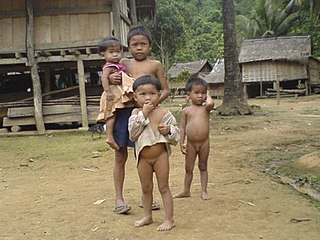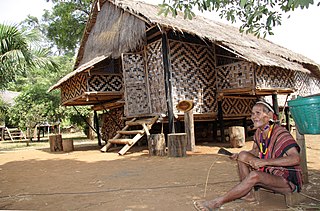Related Research Articles
The Ơ Đu (O'du) are an aboriginal ethnic group in Vietnam and Laos. Their total population is more than 570.

The fifteen Katuic languages form a branch of the Austroasiatic languages spoken by about 1.3 million people in Southeast Asia. People who speak Katuic languages are called the Katuic peoples. Paul Sidwell is the leading specialist on the Katuic languages. He notes that Austroasiatic/Mon–Khmer languages are lexically more similar to Katuic and Bahnaric the closer they are geographically. He says this geographic similarity is independent of which branch of the family each language belongs to. He also says Katuic and Bahnaric do not have any shared innovations, so they do not form a single branch of the Austroasiatic family, but form separate branches.

The Khmu are an ethnic group of Southeast Asia. The majority (88%) live in northern Laos where they constitute the largest minority ethnic group, comprising eleven percent of the total population. Alternative historical English spellings include Kmhmu, Kemu, and Khammu, among others.

The Mlabri or Mrabri, also called the Phi Tong Luang, are an ethnic group of Thailand and Laos, and have been called "the most interesting and least understood people in Southeast Asia". Only about 400 or fewer Mlabris remain in the world today, with some estimates as low as 100. A hill tribe in northern Thailand along the border with Laos, they have been groups of nomadic hunter-gatherers. Those in Thailand live close to the Hmong and northern Thai. Those living in Laos live close to other ethnic groups.
Mlabri is a language spoken by the Mlabri people in the border area between Thailand and Laos.

The Lua people are a minority ethnic group native to Laos, although there is now a sizable community living in Thailand. Lua' is their preferred autonym (self-designation), while their Lao neighbours tend to call them Thin, T'in or Htin. Another term for this group is Lawa. There are two subgroups: the Mal and the Phai or Pray.
The Maniq or Mani are an ethnic group of Thailand. They are more widely known in Thailand as the Sakai, a controversial derogatory term meaning 'barbarism'. They are the only Negrito group in Thailand and speak a variety of related Aslian languages, primarily Kensiu and Ten'edn, which do not have standard writing systems.

The Bru are an indigenous ethnic group living in Thailand, Laos, and Vietnam. They speak a Katuic language, kaubru unlike the Brao, who speak a Western Bahnaric language. The Bru are not found in northeastern Cambodia. The Lun, Kreung, Kavet, Amba and Brao Tanap groups in northeastern Cambodia are actually sub-groups of the Brao, not the Bru. The Brao sub-groups in Laos are the Lun, Kavet, Jree, Ka-ying, and the Hamong.
The Mal are an ethnic group native to Laos and Thailand. They are one of two sub-groups of the Lua people.
The Ksingmul, also known as Con Pua, Puộc, and Pụa, are an ethnic group in Vietnam and Laos. In Vietnam, they live primarily in the northwest, in the provinces of Sơn La and Lai Châu. The group numbers approximately 29,503 people and its language is in the Khmuic languages group of the Mon–Khmer language family.

Khmuic peoples refers to a group of ethnic groups of Southeast Asia.

Laotian society is a society characterized by semi-independent rural villages engaged in subsistence agricultural production. Ethnic, geographic, and ecological differences create variations in the pattern of village life from one part of the country to another, but the common threads of village self reliance, limited regional trade and communication, and identification with one's village and ethnic group persist regardless of the setting. Rural trade networks, however, have been a part of life since the 1950s. Except near the larger towns and in the rich agricultural plains of Vientiane and Savannakhét, villages are spaced at least several kilometers apart and the intervening land variously developed as rice paddy and swidden fields or maintained as buffer forest for gathering wild plants and animals, fuelwood, and occasional timber harvest.
Alak is a language spoken by some 4,000 people in southern Laos, especially in the Provinces of Salavan and Sekong. It is closely related to the language spoken by the Bahnars of Vietnam. It includes two dialects, Alak proper and Harak.
The Alak or Hrlak are an Austroasiatic ethnic group of southern Laos, living mainly in Salavan Province. They speak the Alak language. a lot is known of their history, though as an Austroasiatic-speaking group, their origin is presumably in the Central Highlands of Vietnam.
Lamet is a Mon–Khmer language of Laos. There are also one hundred speakers in Lampang Province, Thailand, where it is known as Khamet. Lamet speakers call their language [χəmɛːt], or less commonly [kʰəmɛːt].
Nyaheun is a Mon–Khmer language of the Bahnaric branch spoken in southern Laos. Chazée (1999:95) estimates the population at 4,200, while the 1995 Laotian census places the Nyaheun population at 5,152. According to Ethnologue, the language is "vigorous," which means it is spoken by people of all ages in its home community.
Oʼdu, or Iduh, is a Mon–Khmer language of Vietnam and Laos. Once spoken by about 300 people in Tương Dương district, Nghệ An province, Vietnam, it is now considered to be almost extinct.
Mal, also known as Thin, is a Mon–Khmer language of Laos and Thailand. It is one of several closely related languages which go by the names Thin or Prai.
Jedek is an Aslian language from the Austroasiatic family first reported in 2017. Jedek speakers describe themselves as ethnic Menriq or Batek to outsiders, but their language, although very closely related, is distinct from these languages.
References
- ↑ "Results of Population and Housing Census 2015" (PDF). Lao Statistics Bureau. Retrieved 1 May 2020.
- 1 2 3 4 5 6 World Culture Encyclopedia-Lamet